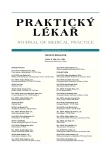Relaxation techniques: what relax and why
Authors:
K. Nešpor; A. Baková
Authors‘ workplace:
Ředitel: MUDr. Martin Hollý
; Primář: MUDr. Karel Nešpor, CSc.
; Psychiatrická léčebna Bohnice, Praha
; Odděleni léčby závislostí – muži
Published in:
Prakt. Lék. 2012; 92(3): 171-172
Category:
Therapy
Overview
Relaxation techniques are used for prevention and treatment of many diseases. The principle on which they are based relaxation technique is relatively simple. Induces one or more physical or psychological changes that are typical for relaxation. This then leads to further changes. It is a good influence on the physical features that would be difficult to directly influence, such as the secretion of adrenal hormones. This leads to total relaxation.
In addition to the overall relaxation is in place and clinical practice and applied partial relaxation. This can be practiced as an adjunct to general relaxation in everyday situations and to moderate stress or symptoms.
Key words:
relaxation, prevention, treatment.
Sources
1. Bastani, F., Hidarnia, A., Kazemnejad, A. et al., A randomized controlled trial of the effects of applied relaxation training on reducing anxiety and perceived stress in pregnant women. J. Midwifery Womens Health 2005, 50(4), e 36-40.
2. de Niet, G., Tiemens, B., Lendemeijer, B., Hutschemaekers, G. Music-assisted relaxation to improve sleep quality: meta-analysis. J. Adv. Nurs. 2009, 65(7), p. 1356-1364.
3. Ekman, P., Davidson, R.J., Friesen, W.V. The Duchenne smile: emotional expression and brain physiology. II. J. Pers. Soc. Psychol. 1990, 58(2), p. 342-353.
4. Gitlin, B, Martin, J., Shear, M.K. et al. Behavior therapy for panic disorder. J. Nerv. Ment. Dis. 1985, 173(12), p. 742-743.
5. Gustavsson, C., von Koch, L. Applied relaxation in the treatment of long-lasting neck pain: a randomized controlled pilot study. J. Rehabil. Med. 2006, 38(2), p. 100-107.
6. Han, J.N., Stegen, K., De Valck, C. et al. Influence of breathing therapy on complaints, anxiety and breathing pattern in patients with hyperventilation syndrome and anxiety disorders. J. Psychosom. Res. 1996, 41(5), p. 481-493.
7. Kabat-Zinn, J., Wheeler, E., Light, T. et al. Influence of a mindfulness meditation-based stress reduction intervention on rates of skin clearing in patients with moderate to severe psoriasis undergoing phototherapy (UVB) and photochemotherapy (PUVA). Psychosom. Med. 1998, 60(5), p. 625-632.
8. Kim, K.S., Lee, S.W., Choe, M.A. et al. Effects of abdominal breathing training using biofeedback on stress, immune response and quality of life in patients with a mastectomy for breast cancer. Taehan Kanho Hakhoe Chi 2005, 35(7), p. 1295-1303.
9. Manzoni, G.M., Pagnini, F., Castelnuovo, G., Molinari, E. Relaxation training for anxiety: a ten-years systematic review with meta-analysis. BMC Psychiatry 2008, 8, p. 41.
10. Melville, G.W., Chang, D., Colagiuri, B. et al. Fifteen minutes of chair-based yoga postures or guided meditation performed in the office can elicit a relaxation response. Evid Based Complement Alternat Med. 2012, 2012, 501986.
11. Nešpor, K. Uvolněně a s přehledem. Relaxace a meditace pro moderního člověka. Grada, Praha, 1998; 96. Volně dostupné na www.drnespor.eu.
12. Palermo, T.M., Eccleston, C., Lewandowski, A.S. et al. Randomized controlled trials of psychological therapies for management of chronic pain in children and adolescents: an updated meta-analytic review. Pain 2010, 148(3), p. 387-397.
13. Ponniah, K., Hollon, S.D. Empirically supported psychological treatments for adult acute stress disorder and posttraumatic stress disorder: a review. Depress Anxiety 2009, 26(12), p. 1086-1109.
14. Santaella, D.F., Araújo, E.A., Ortega, K.C. et al. Aftereffects of exercise and relaxation on blood pressure. Clin J. Sport Med. 2006, 16(4), p. 341-347.
15. Stetter, F., Kupper, S. Autogenic training: a meta-analysis of clinical outcome studies. Appl. Psychophysiol. Biofeedback 2002, 27(1), p. 45-98.
16. Tsai, C.M., Chou ,S.L., Gale, E.N., McCall, W.D. Jr. Human masticatory muscle activity and jaw position under experimental stress. J. Oral. Rehabil. 2002,29(1), p. 44-51.
Labels
General practitioner for children and adolescents General practitioner for adultsArticle was published in
General Practitioner

2012 Issue 3
Most read in this issue
- Testicular microlithiasis
- Nursing interventions in home care
- The influence of ageing on cognitive functions and their evaluation in general practice
- General practitioner and rehabilitation
